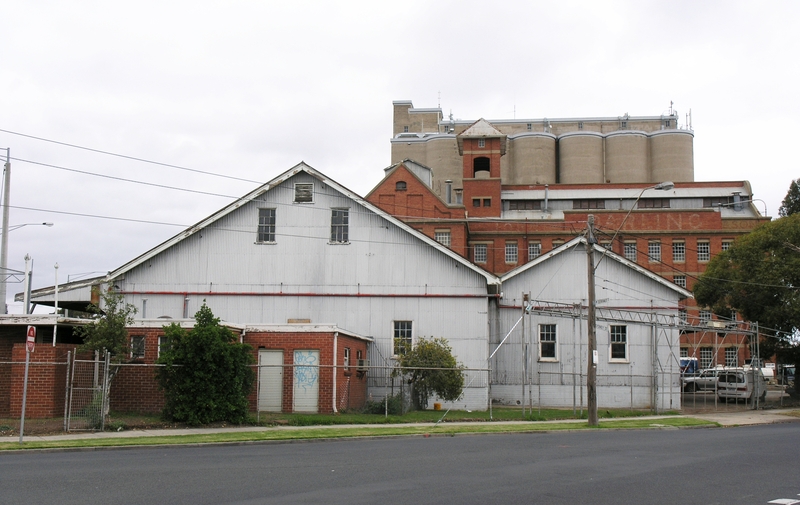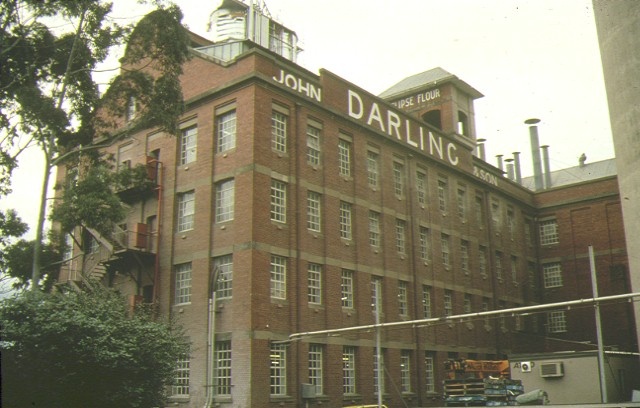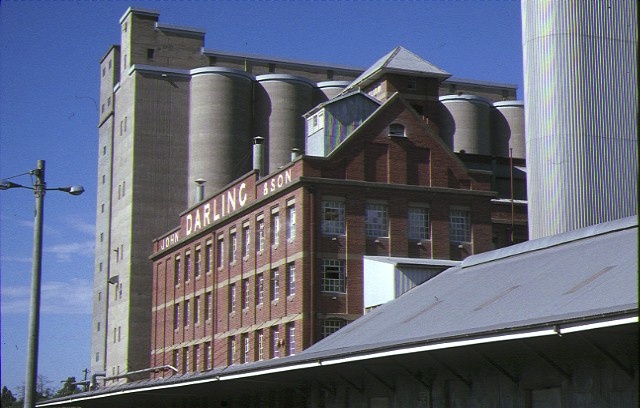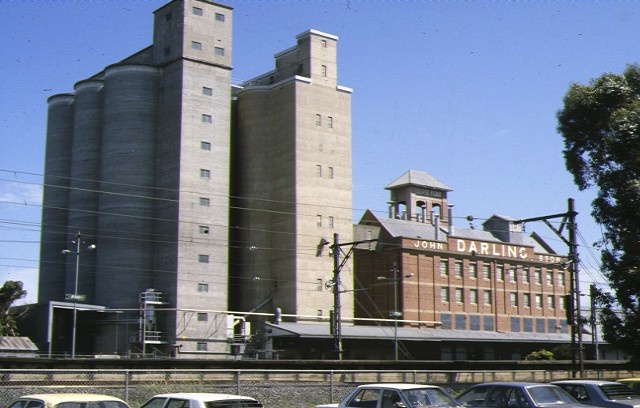Back to search results
JOHN DARLING AND SON FLOUR MILL
74 SYDNEY STREET ALBION, BRIMBANK CITY
JOHN DARLING AND SON FLOUR MILL
74 SYDNEY STREET ALBION, BRIMBANK CITY
All information on this page is maintained by Heritage Victoria.
Click below for their website and contact details.
Victorian Heritage Register
-
Add to tour
You must log in to do that.
-
Share
-
Shortlist place
You must log in to do that.
- Download report

JOHN DARLING AND SON FLOUR MILL SOHE 2008













On this page:
Statement of Significance
What is significant?
The John Darling and Son Flour Mill is an industrial complex including a T-shaped red brick mill building with four main stories, basement, attic and tower, a timber and iron storehouse, rail sidings, loading platform and canopy (1926-7) and reinforced concrete silo blocks (1939 and 1973).
How is it significant?
The John Darling and Son Flour Mill is of architectural and historical significance to the State of Victoria. It satisfies the following criteria for inclusion in the Victorian Heritage Register:
Criterion A
Importance to the course, or pattern, of Victoria’s cultural history.
Criterion D
Importance in demonstrating the principal characteristics of a class of cultural places and objects.
Criterion H
Special association with the life or works of a person, or group of persons, of importance in Victoria’s history.
Criterion A
Importance to the course, or pattern, of Victoria’s cultural history.
Criterion D
Importance in demonstrating the principal characteristics of a class of cultural places and objects.
Criterion H
Special association with the life or works of a person, or group of persons, of importance in Victoria’s history.
Why is it significant?
The John Darling and Son Flour Mill is historically significant in representing the development of the flour industry in Victoria. It is a prominent and intact example of a large capacity roller flour mill constructed in the twentieth century. The John Darling and Son Flour Mill was constructed on a site which takes advantage of convenient rail links to the wheat belt of north west Victoria, with rail sidings, loading platform and canopy still evident. The John Darling and Son Flour Mill also contains some machinery which demonstrates the development of the flour milling process. [Criterion A]
The John Darling and Son Flour Mill is architecturally significant as one of the most notable and intact examples of a roller flour mill constructed in the twentieth century in Victoria. It contains one of the most elaborate brick mill buildings in Victoria, comprising a tower, signage parapets, cornice and distinctive gable ends. The unusual T-shaped plan of the mill building reflects the division of the milling process: the wheat cleaning/packing operations taking place in the short section of the T, and the milling itself taking part in the long section of the T. An adjoining timber and iron storehouse is contemporaneous with the mill and along with loading platform, rail sidings and canopy, completes the complex. Later additions such as the reinforced concrete silos demonstrate the evolution of the industrial development on the site. [Criterion D]
The John Darling and Son Flour Mill has a strong historical association with the Darling family who had a considerable influence on the flour milling industry, not only in Victoria but also throughout Australia. Large, white lettering remains on the east, north and south facades of the mill building reading ‘John Darling & Son’ which demonstrates this association. The eastern elevation contributes a bold expression of the Darling family’s perceived image in terms of the massing and relationship between elements including the picturesque tower, demonstrating landmark qualities. The John Darling and Son Flour Mill also has a strong association with Hugh Victor McKay (1865-1926) who was an inventor and pioneer industrialist of national importance, and his dream to establish an ‘industrial garden city’ at Sunshine. [Criterion H]
The John Darling and Son Flour Mill is architecturally significant as one of the most notable and intact examples of a roller flour mill constructed in the twentieth century in Victoria. It contains one of the most elaborate brick mill buildings in Victoria, comprising a tower, signage parapets, cornice and distinctive gable ends. The unusual T-shaped plan of the mill building reflects the division of the milling process: the wheat cleaning/packing operations taking place in the short section of the T, and the milling itself taking part in the long section of the T. An adjoining timber and iron storehouse is contemporaneous with the mill and along with loading platform, rail sidings and canopy, completes the complex. Later additions such as the reinforced concrete silos demonstrate the evolution of the industrial development on the site. [Criterion D]
The John Darling and Son Flour Mill has a strong historical association with the Darling family who had a considerable influence on the flour milling industry, not only in Victoria but also throughout Australia. Large, white lettering remains on the east, north and south facades of the mill building reading ‘John Darling & Son’ which demonstrates this association. The eastern elevation contributes a bold expression of the Darling family’s perceived image in terms of the massing and relationship between elements including the picturesque tower, demonstrating landmark qualities. The John Darling and Son Flour Mill also has a strong association with Hugh Victor McKay (1865-1926) who was an inventor and pioneer industrialist of national importance, and his dream to establish an ‘industrial garden city’ at Sunshine. [Criterion H]
Show more
Show less
-
-
JOHN DARLING AND SON FLOUR MILL - History
John Darling & Son purchased the site at 74 Sydney Street, Albion, in 1921 and opened their new roller mill on July 10, 1922. They purchased the site from Hugh Victor McKay,machinery manufacturer, who was well known as the owner of the nearby Sunshine Harvester Works.From early in its history, the mill operated night and day as the Darling family continued to make inroads into the flour export trade. Disaster struck in February 1926 when the mill building was destroyed by fire.It was announced the day after the fire, however, that the mill would be rebuilt. The rebuilding program commenced that same year and the new mill was completed and operational by 1927.This is the mill that still stands today.The adjacent grainstore building was also constructed at this time in association with the mill building, as well as the rail sidings, loading platform and canopy.
Between 1927 and 1990 when the mill ceased operation,various buildings and features were added and removed from the complex as the needs of the mill operation changed and new technologies were developed. An MMBW plan of 1934 indicates the existence of three major buildings on the site during the first decade after the rebuilding of the mill in 1926, including the T-shaped brick mill building, the timber and iron grain store to the north and a detached wheat storage-shed to the south (since demolished).Smaller structures included an amenities block to the north, water tank and pump house (all since demolished). Later additions to the site can be seen in a 1989 plan of the mill complex. From 1939 additional buildings/features included the following:
-Reinforced concrete silos built 1939 and 1973, adjacent to the mill building;
-Office and laboratory of 1951 fronting Sydney Street;
-Former workshop, 1960s, modified 1981 and 2013,fronting Ferguson Street;
-Five steel flour bins added to the site in 1969, 1970 and 1984, adjacent to the mill building;
-Office building of 1971 fronting Sydney Street;
-Locker room of 1971 fronting Sydney Street;
-Maintenance Depot fronting Ferguson Street 1981.
Of the list above, only the reinforced concrete silos built 1939 and 1973 and the building fronting Ferguson Street remain at the site,with other buildings at the site cleared from c.2013.
JOHN DARLING AND SON FLOUR MILL - Permit Exemptions
General Exemptions:General exemptions apply to all places and objects included in the Victorian Heritage Register (VHR). General exemptions have been designed to allow everyday activities, maintenance and changes to your property, which don’t harm its cultural heritage significance, to proceed without the need to obtain approvals under the Heritage Act 2017.Places of worship: In some circumstances, you can alter a place of worship to accommodate religious practices without a permit, but you must notify the Executive Director of Heritage Victoria before you start the works or activities at least 20 business days before the works or activities are to commence.Subdivision/consolidation: Permit exemptions exist for some subdivisions and consolidations. If the subdivision or consolidation is in accordance with a planning permit granted under Part 4 of the Planning and Environment Act 1987 and the application for the planning permit was referred to the Executive Director of Heritage Victoria as a determining referral authority, a permit is not required.Specific exemptions may also apply to your registered place or object. If applicable, these are listed below. Specific exemptions are tailored to the conservation and management needs of an individual registered place or object and set out works and activities that are exempt from the requirements of a permit. Specific exemptions prevail if they conflict with general exemptions. Find out more about heritage permit exemptions here.Specific Exemptions:Introduction
The purpose of this information is to assist owners and other interested parties when considering or making decisions regarding works to a registered place. It is recommended that any proposed works be discussed with an officer of Heritage Victoria prior to making a permit application. Discussing proposed works will assist in answering questions the owner may have and aid any decisions regarding works to the place.
It is acknowledged that alterations and other works may be required to keep places and objects in good repair and adapt them for use into the future. However, under the Act a person must not knowingly, recklessly or negligently remove, relocate or demolish, damage or despoil, develop or alter or excavate all or any part of any part of a registered place without approval. It should be noted that the definition of ‘develop’ in the Act includes any works on, over or under the place.
If a person wishes to undertake works or activities in relation to a registered place or registered object, they must apply to the Executive Director for a permit. The purpose of a permit is to enable appropriate change to a place and to effectively manage adverse impacts on the cultural heritage significance of a place as a consequence of change. If an owner is uncertain whether a heritage permit is required, it is recommended that Heritage Victoria be contacted.
Permits are required for anything which alters the place or object, unless a permit exemption is granted. Permit exemptions usually cover routine maintenance and upkeep issues faced by owners as well as minor works or works to the elements of the place or object that are not significant. They may include appropriate works that are specified in a conservation management plan. Permit exemptions can be granted at the time of registration (under section 38 of the Act) or after registration (under section 92 of the Act). It should be noted that the addition of new buildings to the registered place, as well as alterations to the interior and exterior of existing buildings requires a permit, unless a specific permit exemption is granted.
Disrepair of registered place or registered object
Under section 152 of the Act, the owner of a registered place or registered object must not allow that place or object to fall into disrepair.
Failure to maintain registered place or registered objectUnder section 153 of the Act, the owner of a registered place or registered object must not fail to maintain that place or object to the extent that its conservation is threatened.
Conservation management plansIt is recommended that a Conservation Management Plan is developed to manage the place in a manner which respects its cultural heritage significance.
Archaeology
There is no identified archaeology of State level significance at the place. However, any works that may affect historical archaeological features, deposits or artefacts at the place is likely to require a permit, permit exemption or consent. Advice should be sought from the Archaeology Team at Heritage Victoria.
Aboriginal cultural heritage
To establish whether this place is registered under the Aboriginal Heritage Act 2006 please contact First Peoples – State Relations. The Heritage Act 2017 and the Aboriginal Heritage Act 2006 are separate pieces of legislation. Please be aware that both Acts are required to be satisfied and satisfying the requirements of one Act may not satisfy the requirements of the other.
If any Aboriginal cultural heritage is discovered or exposed at any time it is necessary to immediately contact First Peoples – State Relations to ascertain requirements under the Aboriginal Heritage Act 2006. If works are proposed which have the potential to disturb or have an impact on Aboriginal cultural heritage it is necessary to contact First Peoples – State Relations in the Department of Premier and Cabinet to ascertain any requirements under the Aboriginal Heritage Act 2006.
Other approvals
Please be aware that approval from other authorities (such as local government) may be required to undertake works.
Notes
- All works should ideally be informed by a Conservation Management Plan prepared for the place. The Executive Director is not bound by any Conservation Management Plan, and permits still must be obtained for works suggested in any Conservation Management Plan.
- Nothing in this determination prevents the Heritage Council from amending or rescinding all or any of the permit exemptions.
- Nothing in this determination exempts owners or their agents from the responsibility to seek relevant planning or building permits where applicable.
General Conditions- All exempted alterations are to be planned and carried out in a manner which prevents damage to the fabric of the registered place.
- Should it become apparent during further inspection or the carrying out of works that original or previously hidden or inaccessible details of the place are revealed which relate to the significance of the place, then the exemption covering such works must cease and Heritage Victoria must be notified as soon as possible.
Permit Exemptions
The following permit exemptions are not considered to cause harm to the cultural heritage significance of the John Darling and Son Flour Mill.
General- Minor repairs and maintenance which replaces like with like. Repairs and maintenance must maximise protection and retention of significant fabric and include the conservation of existing details or elements. Any repairs and maintenance must not exacerbate the decay of fabric due to chemical incompatibility of new materials, obscure fabric or limit access to such fabric for future maintenance.
- Maintenance, repair and replacement of existing external services such as plumbing, electrical cabling, surveillance systems, pipes or fire services which does not involve changes in location or scale, or additional trenching.
- Repair to, or removal of items such as antennae; aerials; and air conditioners and associated pipe work, ducting and wiring. This exemption includes minor maintenance and upgrade works to the existing telecommunications infrastructure located on the concrete silos.
- Painting of previously painted external and internal surfaces in the same colour, finish and product type provided that preparation or painting does not remove all evidence of earlier paint finishes or schemes. This exemption does not apply to areas where there are specialist paint techniques present.
- Cleaning including the removal of surface deposits and graffiti using low-pressure water (to maximum of 300 psi to the surface being cleaned), neutral detergents, and mild brushing and scrubbing with plastic (not wire) brushes.
Landscape/outdoor areas
Hard landscaping and services- Subsurface works to existing water, drainage, gas and utility installations provided that the land surface is returned to the original configuration and appearance on completion of works.
- Like for like repair and maintenance of existing hard landscaping including carparks, paving, footpaths.
- Removal or replacement of external directional signage provided the size, location and material remains the same. This exemption does not apply to historic signage.
- Removal of cyclone wire fencing.
Gardening, trees and plants- The processes of gardening including mowing, pruning, mulching, fertilising, removal of dead or diseased plants, replanting of existing garden beds, disease and weed control and maintenance to care for existing plants.
- Removal of trees and plants.
- Removal of environmental and noxious weeds.
Albion Railway Station Carpark- Ground level works to maintain, reconfigure or improve the Albion Railway Station Carpark including the repair or resealing of the carpark surface; the repair, removal, installation or maintenance of kerbing, bollards, speed humps, wheel stops and boom gates; the maintenance, removal or installation of plantings and landscaping; the repair, removal or installation of directional signage and line marking; and the repair, removal or installation of lighting. This exemption does not include extending the footprint of the existing carpark.
Rail Corridor- Routine maintenance, repair and access works to service the rail corridor which allow for the safe operation of rail services to occur. This exemption includes repair, alteration and replacement of the associated boundary fence.
Public Safety and Security- The erection of temporary security fencing, scaffolding, hoardings or alarm and surveillance systems to prevent unauthorised access or secure public safety which will not adversely affect the significant fabric of the place provided that temporary structures are removed within 12 months of erection.
- General maintenance for the purposes of safety and security including the removal of broken glass, the temporary shuttering of windows and covering of holes providing this work is reversible and does not result in harm to significant fabric.
- Works or activities, including emergency stabilisation, necessary to secure safety in an emergency where a structure or part of a structure has been irreparably damaged or destabilised and poses a safety risk to its users or the public. It is acknowledged that in some instances additional damage to significant fabric may be required to stabilise and make safe. In these instances, every attempt must be made to conserve and retain as much significant fabric as possible. The Executive Director must be notified within seven days of the commencement of these works or activities.
CCTV/litter enforcement cameras- Attachment, operation, maintenance and removal of wireless CCTV/litter enforcement cameras, where they are affixed to existing lighting poles and do not require the installation of new support structures or infrastructure
-
-
-
-
-
MASSEY FERGUSON COMPLEX
 Victorian Heritage Register H0667
Victorian Heritage Register H0667 -
HV MCKAY MEMORIAL GARDENS AND CHURCH
 Victorian Heritage Register H1953
Victorian Heritage Register H1953 -
McKay Housing Estate - King Edward Ave
 Brimbank City
Brimbank City
-
"1890"
 Yarra City
Yarra City -
"AMF Officers" Shed
 Moorabool Shire
Moorabool Shire -
"AQUA PROFONDA" SIGN, FITZROY POOL
 Victorian Heritage Register H1687
Victorian Heritage Register H1687
-
10 Down Street
 Yarra City
Yarra City
-
-















